It seems like ages ago that we chatted about my adventures with a linen that I was testing for possible use in constructing a tote bag with hand embroidered pockets.
The whole thing was a wash – I really abhorred the linen! – so I moved on to some cotton alternatives. I could have opted for better linen, no doubt, but since this whole project is somewhat experimental, I want to keep the cost point relatively low.
So I decided to try twill and duck.
Twill and Duck. I like those words together!
Here’s the whole idea for the project so far. I’ll tell you what I’m planning, we can chat about the two fabrics, and then I’ll keep you apprized of how things go on the stitching and, ultimately, on the construction & finishing of my Masterpiece Tote. Ha.
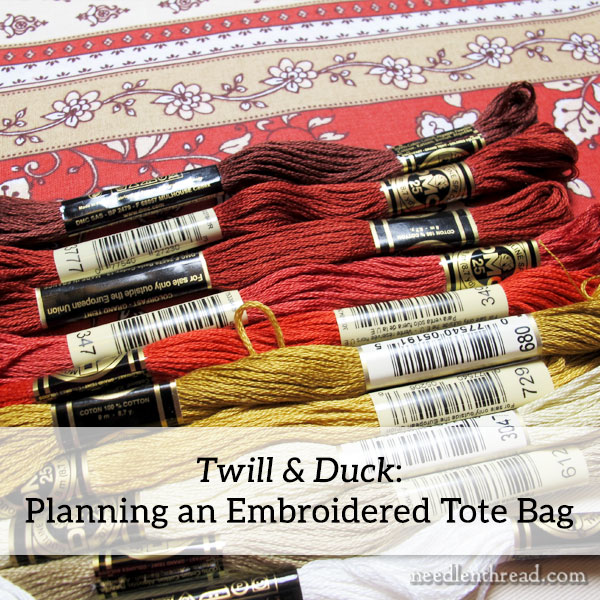
This is essentially the color conception for my embroidered tote idea, pulling the colors of embroidery floss based on the cotton lining fabric I plan to use for the bag.
My plan right now is to embroider at least one outside pocket for a tote. The bag itself will be predominantly a natural color with a red base and straps, with an embroidered pocket on one side of the outside of the tote (maybe on both sides, depending on how adventuresome I feel and how quickly the stitching goes!), with a cotton print for the inside lining.
When I initially started this project, I had planned on yellows and blues. Somehow, these morphed into reds and tans. That’s not to say I won’t go back to yellows and blues…. but for now, it’s reds and tans.
(I’m not sure how that happened!)
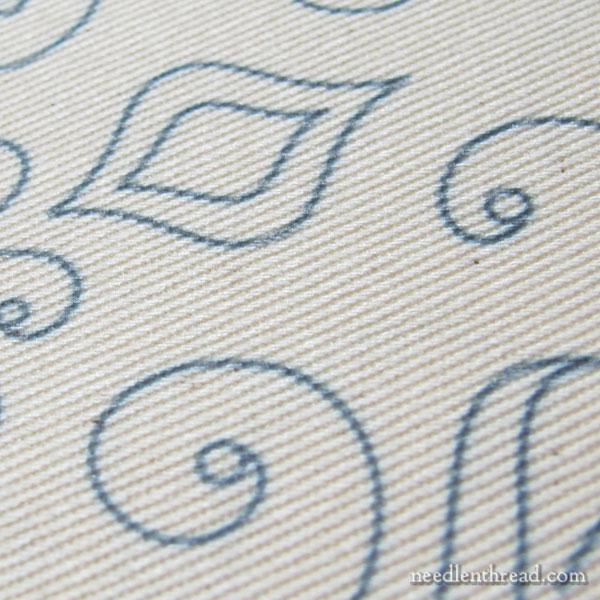
Meet Twill!
First, a bit about the fabrics.
For our purposes here, I’m talking about twill as a heavy-ish weight cotton fabric with a diagonal weave. Today, the most common twill fabric around the world is most likely denim – jeans are made from a twill weave fabric.
In the needlework world, the most common use for twill is in crewel embroidery, where linen twill is the typical historical ground fabric for crewel work. If you’ve done “real” crewel work, with wool on the traditional ground, most likely you were stitching on linen twill.
Twill is simply a type of weave. It looks, if examined closely, like a diagonally ribbed fabric, due to the sequence of weaving. It’s a very sturdy fabric, so it’s used often in the construction of work clothes and the like. Like most fabrics, it can come in different weights, though, but, when considering cotton twill especially, lighter weight twills are still a fairly heavy fabric.
Twill has a nice drape and a nice “hand.” This particular twill that I’m using is a more medium-weight twill. There are certainly heavier twills out there, but I liked the color (a natural color with a bit of speckle) and feel of this particular twill, so I went with it.
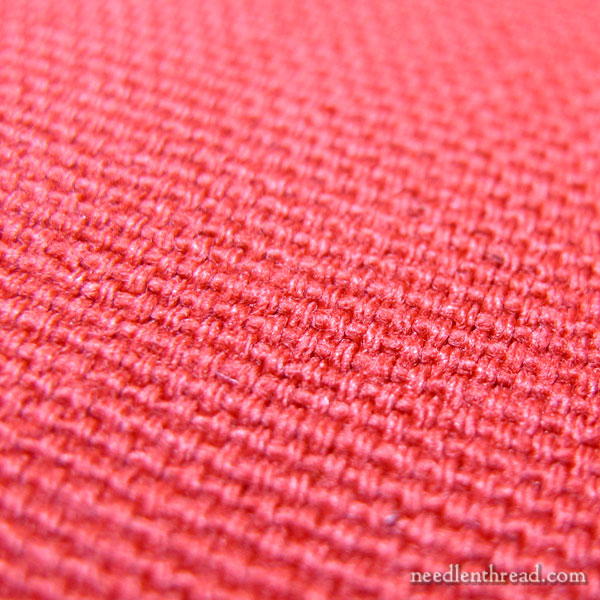
Meet Duck!
Hmmmm. Duck meat?
Duck is also a very sturdy cotton cloth, often used in the construction of outdoor textiles like awnings and whatnot, depending on the weight of the duck. It has a typical square weave (or plain weave). It’s favored not just for its sturdy construction, but for its availability in a wide range of colors.
Duck is often used interchangeably for “canvas” – you often hear the term “canvas duck” as a fabric. I think when people are talking about “canvas duck,” though, they generally mean the very heavy weight duck suitable for outdoor textiles. I think duck can be considered a type of canvas – canvas and duck are woven the same – but it’s usually a little lighter than canvas and it has a smoother hand. Canvas is more rugged and not quite as smooth.
Twill and duck are both heavy cotton fabrics, and really, the only important thing that distinguishes the two for my purposes is the weave. Twill has that diagonal, ribbed weave on close inspection, but duck is plain weave.
The twill I’m using is a little lighter weight than the duck, but neither are as heavy as they could be in their particular fabric categories.
How Do They Work for Hand Embroidery?
Neither twill nor duck are as easy to stitch through as a lighter weight linen or cotton that you might be accustomed to for needlework.
But they take embroidery well, like any natural fabric. There’s no real trick to working with either of them, except that they require a sharp needle. You’ll want to use a crewel (also called “embroidery”) needle or a chenille needle when embroidering on either fabric – definitely not a blunt tapestry needle!
Generally, neither twill nor duck require a lining fabric, as they’re both heavy fabrics and can pretty much support any density of stitching well.
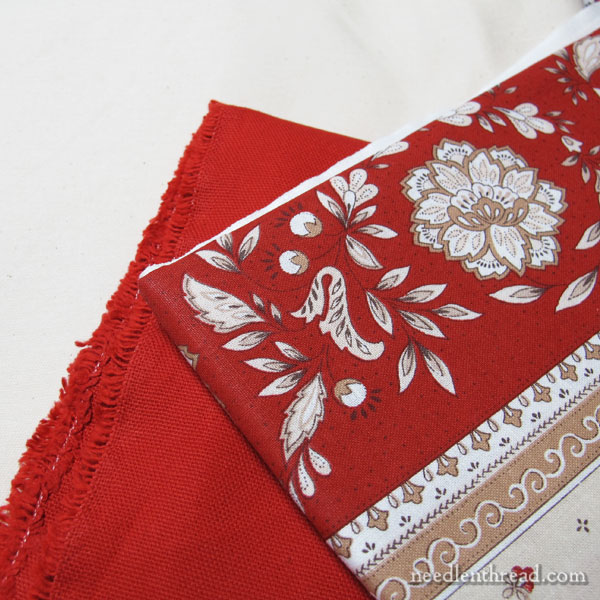
Preparing for Stitching
If you’re planning to launder the thing you’re making from the duck or twill, it’s pretty important to launder the fabric before embroidering it. Cotton shrinks, and both the duck and the twill will shrink when laundered. Better to get the shrink out before embroidering than to be disappointed with puckering!
In fact, I’m all for pre-washing fabric that I intend to use for handwork, whether I do it in the machine or by hand. Mostly, for hand embroidered projects on good linen, I’ll wash the linen by hand in a series of hot and cold rinses.
With cotton for constructing things – like the twill and duck – I find it easier just to throw the stuff in the washing machine and then either to line dry it or put it in the dryer, but don’t let it dry completely before ironing.
It’s best to iron both of these fabrics while they’re still a little damp – it makes it much easier to get to an absolutely smooth finish, especially with the duck.
Definitely iron the fabric before transferring your design! Never transfer an embroidery design onto wrinkly fabric, unless the wrinkly fabric is an integral part of your design. The outcome, otherwise, won’t be pretty!
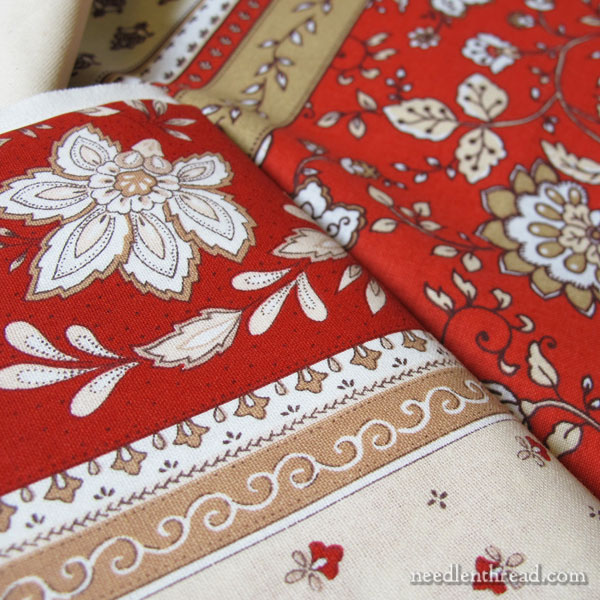
If whatever you’re making also has a cotton lining (mine does), it’s a good idea to wash the lining fabric, too.
Now, if you never plan to launder the thing you’re making, do you have to wash the fabrics and get the shrink out? Not necessarily! But I always prefer to be safe rather than sorry, especially if I’m putting any time into a project.
Oh, Fabric Grain!
Incidentally, the diagonal weave of the twill might be somewhat deceiving when it comes to cutting the fabric on the grain.
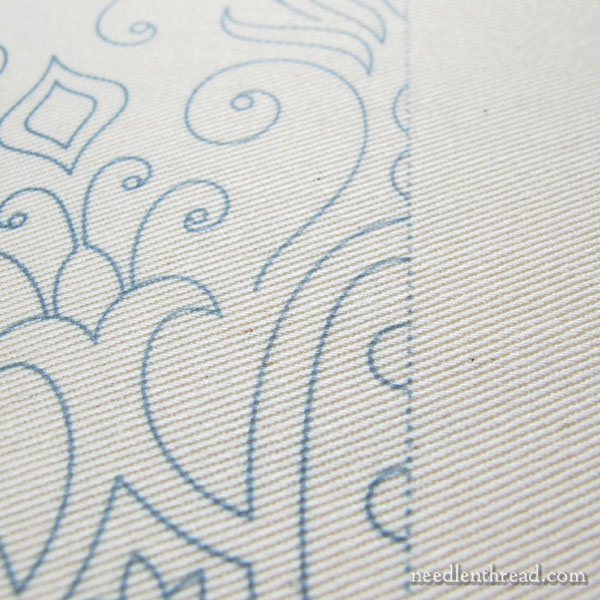
Despite the fact that the twill is a diagonal weave, it should still be cut on the grain. If you’re embroidering on the twill, then, you’ll have to make sure you transfer your design aligned with the grain. If it’s off at all, you’ll end up having to cut your embroidered pieces slightly on the bias, and that could cause problems with construction.
If you’re not sure what I mean by “on the grain” or “on the bias,” this article about cutting fabric on the grain will explain.
To avoid transferring the design on the bias on the twill, I line the design up with the selvage, or edge, of the fabric. Otherwise, the diagonal weave throws me off and I can’t quite be sure I’m getting the design transfer straight.
I transferred my design twice, because one of them ended up a bit cattywampus.
For some reason, the diagonal weave in twill plays with eyes, and I have a hard time seeing beyond the diagonal ribs. When I step back away from the twill, it isn’t as noticeable, but when I’m stitching and really focusing on the fabric, I see the diagonal lines almost more than I see my stitching. They give me a bit of vertigo – kind of like looking at houndstooth designs or small black and white checked fabric. I go googly-eyed! Once I get used to it, though, it isn’t bad. This is one of the reasons I usually opt for the lightest weight twill I can find, if I need linen twill for embroidery. The heavier the twill, the more pronounced the diagonal ribs, and the more my eyes are mesmerized by them. I’m pretty sure this is just a personal thing.
So that’s where I am with Twill and Duck. Next time we visit this slowly-developing project, I’ll show you some of the stitching on the twill and discuss any foibles along the way!